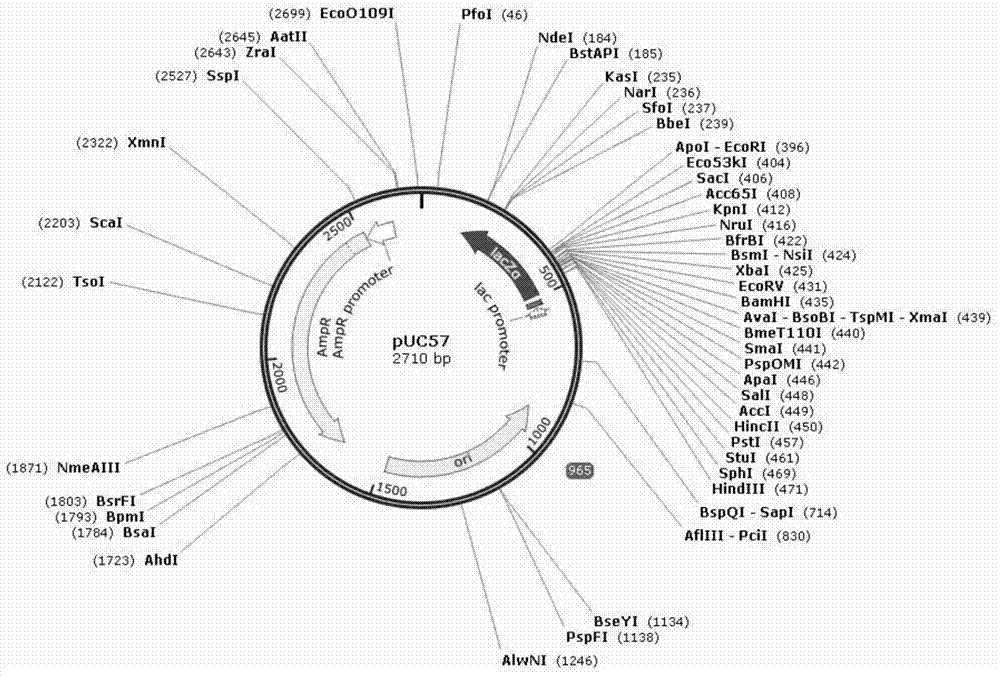A fusion protein sacp, encoding gene, engineering bacteria and application thereof
A fusion protein and coding gene technology, applied in the field of protein biopolymer fusion, to achieve the effect of outstanding application performance, excellent ductility, and uniform length
- Summary
- Abstract
- Description
- Claims
- Application Information
AI Technical Summary
Problems solved by technology
Method used
Image
Examples
Embodiment 1
[0023] Step 1: entrust the fusion protein SACP expression cassette sequence to Biotechnology Co., Ltd. to carry out the whole gene synthesis (the nucleotide sequence is shown in SEQ ID NO.2, the amino acid sequence is shown in SEQ ID NO.1), and use restriction enzymes The cut ligation method was inserted into the EcoR V site on PUC57, and then the E. coli DH5α strain was introduced by chemical method or electric shock method, and the SACP expression strain was obtained by screening on carbenicillin-resistant medium and DNA sequencing verification.
[0024]Step 2: inoculate the fusion protein SACP expression strain clone into 1000mL self-inducing medium, put it in a Erlenmeyer flask at a loading rate of 200mL / L, and ferment and cultivate at 16°C at a shaking speed of 220 rpm for 12h, and then Ammonium sulfate was gradually added to the fermentation broth at a ratio of 35g / 100mL of fermentation broth, precipitated in an ice bath for 30min, and then centrifuged at 12000×g at 4°C f...
Embodiment 2
[0032] Step 1: The preparation of the fusion protein SACP expression strain is the same as in Example 1.
[0033] Step 2: Inoculate the fusion protein SACP expression strain clone into 1000mL self-induction medium, put it in a Erlenmeyer flask with a filling volume of 200mL / L, and culture it at 40°C for 24h at a shaking speed of 220 rpm, and then press The ratio of 35g / 100mL fermentation broth was gradually added to the fermentation broth with ammonium sulfate, precipitated in ice bath for 30min, and then centrifuged at 12000×g at 4°C for 10min to collect the precipitate. The self-induction medium formula is: yeast extract 6.0g / L, tryptone 10.0g / L, casein peptone 10.0g / L, glucose 2.0g / L, dipotassium hydrogen phosphate 8.0g / L, potassium dihydrogen phosphate 9.0g / L, ammonium phosphate 5.0g / L, magnesium sulfate 1.5g / L, calcium chloride 6.0mg / L, cobalt chloride 4.0mg / L, copper chloride 2.0mg / L, manganese sulfate 8.0mg / L, Sodium molybdate 7.0mg / L, boric acid 0.6mg / L, ferric chlori...
Embodiment 3
[0039] Step 1: The fusion protein SACP expression strain is the same as that in Example 1.
[0040] Step 2: Inoculate the fusion protein SACP expression strain clone into 1000mL self-induction medium, put it in a Erlenmeyer flask according to the filling amount of 200mL / L, and cultivate it at 28°C for 18h at a shaking speed of 220 rpm, and then press The ratio of 35g / 100mL fermentation broth was gradually added to the fermentation broth with ammonium sulfate, precipitated in ice bath for 30min, and then centrifuged at 12000×g at 4°C for 10min to collect the precipitate. The self-induction medium formula is: yeast extract 4.0g / L, tryptone 7.5g / L, casein peptone 7.5g / L, glucose 1.0g / L, dipotassium hydrogen phosphate 6.0g / L, potassium dihydrogen phosphate 6.0g / L, ammonium phosphate 3.5g / L, magnesium sulfate 0.85g / L, calcium chloride 4.0mg / L, cobalt chloride 2.25mg / L, copper chloride 2.25mg / L, manganese sulfate 4.5mg / L, Sodium molybdate 5.0mg / L, boric acid 0.35mg / L, ferric chlori...
PUM
| Property | Measurement | Unit |
|---|---|---|
| elongation | aaaaa | aaaaa |
| elongation | aaaaa | aaaaa |
| elongation | aaaaa | aaaaa |
Abstract
Description
Claims
Application Information
 Login to View More
Login to View More - R&D
- Intellectual Property
- Life Sciences
- Materials
- Tech Scout
- Unparalleled Data Quality
- Higher Quality Content
- 60% Fewer Hallucinations
Browse by: Latest US Patents, China's latest patents, Technical Efficacy Thesaurus, Application Domain, Technology Topic, Popular Technical Reports.
© 2025 PatSnap. All rights reserved.Legal|Privacy policy|Modern Slavery Act Transparency Statement|Sitemap|About US| Contact US: help@patsnap.com



